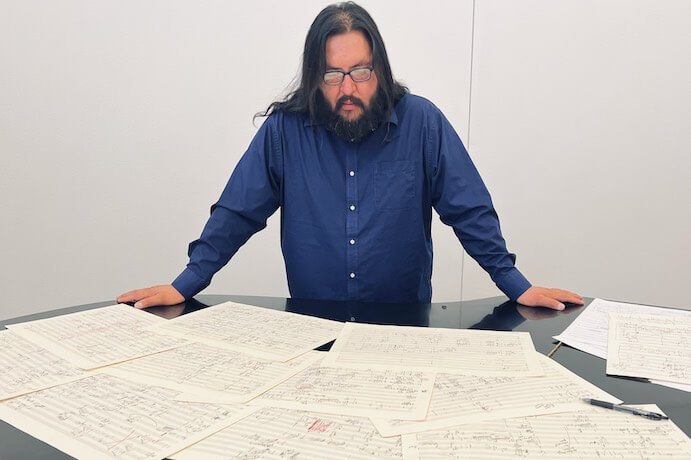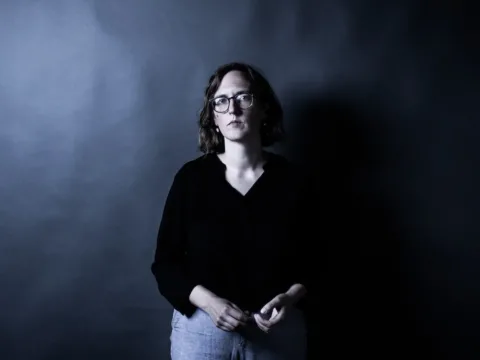Juantio Becenti (Diné/Navajo) composes music that defies easy description. With an organic and intuitive approach to structure and form, Becenti creates dreamlike atmospheres that draw from a variety of musical aesthetics. Born in the Navajo nation, he currently lives in the Four Corners area of New Mexico. He has received commissions from artists such as Dawn Avery (North American Indian Cello Project) and Raven Chacon (Native American Composers Apprenticeship Program) and has had his compositions performed by notable ensembles, including ETHEL, the Claremont Trio, Phoenix Chamber Orchestra, and A Far Cry.
You started composing at a young age. Who or what initially inspired you to create music?
Early in my studies in elementary school, I began learning Beethoven’s music and acquired scores for his complete piano sonatas and complete violin sonatas. This was in the mid-90s, so not an easy task for a reservation kid, but made possible by Dover Publications, as it was relatively cheap. I acquired recordings where I could and would read the scores as I listened to the recordings. No one would think twice about this today when there are thousands of videos with scores on YouTube, but in the mid-90s there was no such thing. I couldn’t tell you precisely what captivated me about the music during that time other than I sensed a great deal of beauty and purpose in the music. It was not so much the structure of the music but rather the “voice” of the music — or the spirit of it, I suppose.
Later in high school, I acquired the complete recordings of Shostakovich’s string quartets, which blew me away; this was my introduction to dissonance on a large scale. After hearing that music, I was determined to work in music and become a composer. To this day, Shostakovich remains a great influence and he is one of my favorite composers.
The titles of many of your works reference natural imagery. Does nature play a significant role in your artistic practice?
Nature surely plays an important role in my work. Perhaps this is due, in no small part, to my Diné (Navajo) heritage, in which nature and places play a pivotal role in terms of identity. I was taught in my youth that there are many locations throughout Dinétah (Navajoland) that hold great significance. Animals, plants, mountains, and rivers are held in great reverence, so it seems only natural that much of my work would center on nature in a similarly meaningful manner.

One striking aspect of your music is the juxtaposition of different aesthetics and styles. How do you conceptualize and approach musical style when you compose?
Though my initial musical studies were pretty standard, I began searching for more and initially found it in Shostakovich, and later Schoenberg and the composers who followed him. Though this new dissonance was rather seductive for me at the time, I always held the music I learned in my youth close to my heart. I am fond of using multiple styles because they seem to propel each other forward in a way that each individual style may not on its own — which of course is just my take on that subject. Though they are different styles at their core, they are the same language with similar grammar. There seems to be tension between chromaticism and whole-tones, both in the literature and my own listening — so, why not combine the two and see what happens?
Can you tell us about your work The Glittering World, which was commissioned and recently premiered by A Far Cry?
The Glittering World is a concertante for solo violin and string orchestra. The piece concerns itself with parts of the Navajo creation story called the Emergence, where semi-divine beings ascended through a series of mono-colored underworlds, becoming increasingly more complex in the process until they finally reached the current world: the “world of many colors,” or the Glittering World. In this world, these beings established the ceremonial complexes and ideologies that continue to guide the Navajo to this day. However, in my piece I decided not to emulate these stories in any concrete or programmatic manner, but to instead highlight and quote music that inspired me on my own musical journey. In a way, I too felt as if I ascended through a series of musical “worlds” to arrive at the point where I may have something musical to contribute. Some of the musical references are quite overt and others are not, and some are embedded in the fabric of the textures themselves. The composers I quoted include Beethoven, Takemitsu, Schoenberg, Shostakovich, and Debussy.
View this post on Instagram
What upcoming compositions or creative work do you have on the horizon?
I have a number of works that I’d like to complete that aren’t commissions, including a piece for viola and piano; a piece for strings, percussion, piano, and flute; a vocal cycle; and a set of solo piano pieces. I’ve had these pieces on my mind for a while now and would very much like to work on them. For some of these, especially the viola and piano piece, I plan on utilizing a homogenous style throughout, which would be a considerable break from my previous work. In a sense, I’d like to see how far I can take a single idea after gaining some experience in writing music. I am a complete fan of chamber music, and, for the most part, these pieces I have planned are mostly chamber works. In some ways, a non-commissioned piece can be more ambitious than a commissioned one. I will certainly try to challenge myself in these planned personal works and see what I can come up with.
I CARE IF YOU LISTEN is an editorially-independent program of the American Composers Forum, and is made possible thanks to generous donor and institutional support. Opinions expressed are solely those of the author and may not represent the views of ICIYL or ACF.
You can support the work of ICIYL with a tax-deductible gift to ACF. For more on ACF, visit the “At ACF” section or composersforum.org.
























